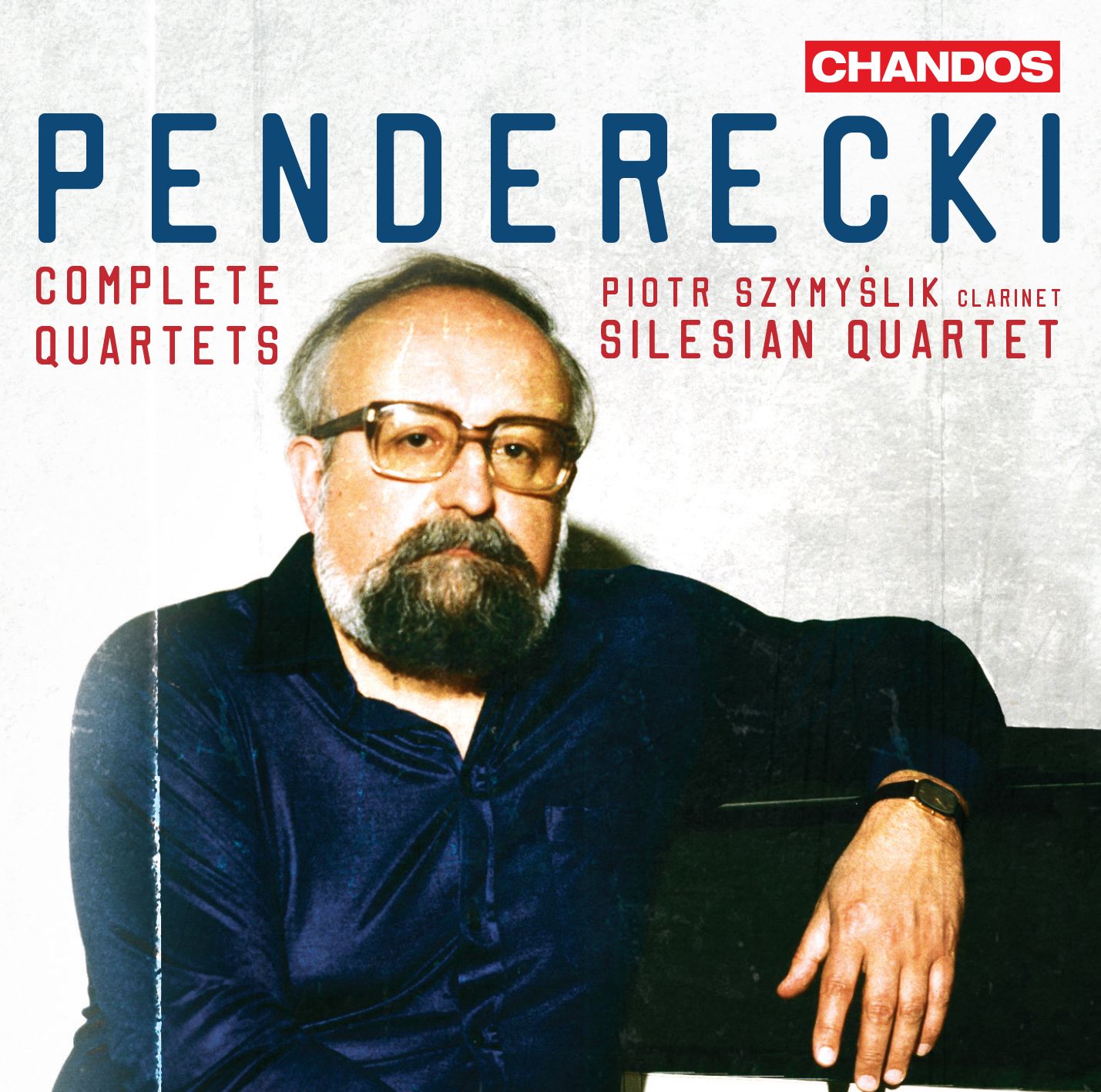Penderecki: Complete Quartets on Chandos
I find these Silesian Quartet performances impeccably aligned with the music

It was with their recording of the chamber music of Grażyna Bacewicz that the Silesian Quartet first came to international prominence. Now, the ensemble has turned its attention to the complete quartets of Krzysztof Penderecki (1933-2020). The recordings span from 2012 to 2021.
The pieces themselves move from the very clear avant-gardisms of the First Quartet (1960) through to the Neo-Romanticism of the Third and Fourth Quartets (2008 and 2016 respectively). The Silesian Quartet also adds the string quartet piece Der unterbrochene Gedanke (1988) and the Quartet for Clarinet and String Trio of 1993 as a bridge between the 1968 Second Quartet and the 2008 Third.
First, though, that String Quartet No. 1, a mere 6 minutes 45 seconds of hard0-hitting, post-Webernian angularity and, occaisonally, noise. Pizzicato rain down like atonal halistones, jagged, jittery. The piece is contemporaneous with such 20th-century masterpieces by Penderecki as Anaklasis (1959) and possibly Penderecki’s most famous piece, the massively touching Threnody for the Victims of Hiroshima (the link is to a YouTube video of the composer himself conducting the Polish National Radio Symphony Orchestra). All three pieces speak the language of unremitting dissonance, of glistening textures, of shards of sound:
The Second Quartet (1968) is about the same duration as the first and is if anything a harder nut to crack. Here we are parallel with Penderecki’s most famous opera, Die Teufel von Laudon (of which opera there is the most amazing Arthaus DVD available). Moments of extreme dissonance vie with charged silences or near-silences. Sometimes the music charges forward in headlong fashion - at others, rhythmic unisons invoke Bartók (particularly that composer’s Fifth String Quartet):
The 1980 piece Der untervrochene Gedanke was written in memory of Penderecki’s friend, the publisher Arno Volk. There is no missing its elegiac aura and lachrymose song; it also contains paossages of punctuating, (dissonant) dance. No wonder its title, translated, means “The Interrupted Thought”:
The next piece represents something of a break in this modernist line. The Quartet for Clarinet and String Trio shows strong links with the chamber music of the nineteenth century. It was the the 1992 recording by the Emerson String Quartet and Mstislav Rostropovich of Schubert’s String Quintet in C major, D 956 tha tinspired Penderecki to pen his piece; here three members of the Silesian Quartet are joined by the clarinettist Piotr Szymyślik. There is the most amazing lyricism here - the lines might be characterised by wide intervallic leaps, but I for one would not categorise them as “disjunct”:
There are four movements - Notturno, Scherzo, Serenade and Abschied (Farewell). The keening gestures that elicit such sadness are remarkable, and this is a superb performance. Just as earlier on the disc the Silesian Quartet had shown their virtuosity and their clear attunement to the avant-garde, here we hear them evoking a most interoir space along with a similarly sympathetic clarinettist. Penderecki opens up astonishingly barren spaces thanks to registral spacing and a motionless, expressionless cello pedal note. This is surely one of the great works for clarinet and strinsg.
The performance of the Schubert that inspired Penderecki is available in one-movement-per-video form on YouTube - here’s the mesmeric slow movement.
Interesting how the solo “voice” (the viola of Łukasz Syrnicki) that opens the Third Quartet seems like a logical contnuation of the Quartet (and yet full 15 years separate them). This third quartet is named “Blätter eines nicht geschriebenen Tagebuches” (Leaves from an Unwritten Diary) and is very different from tge first two quartets. Key areas - initally E flat minor and C sharp minor - are identifiable, for a start. There are moments when one expects the music to burst out into lyrical, mainly stepwise, song. Here's the first movement:
The Notturno is beautiful in an utterly unique way. I only wish it lasted longer:
I love the way the third movement morphs into the fourth, and how the finale seems full of post-Bartókian dance:
The sense of lament in this finale of the longest of Penderecki’s Quartets (the finale is 6:29, the quartet in total 17:14) is remarkable. The members of the Silesian Quartet seem able to make their instruments weep at will; Beata Jankowska-Burzyńska is the superb sound engineer who creates the perfect ambience to hold the performance, and the Producer is listed as the Silesian Quartet itself.
The Fourth Quartet (2016) shares characteristics with the Third - both foreground the viola, and both include folk material. The Fourth, dedicated tothe Belcea Quartet, is a compact six minutes (and ten seconds) that rejoices in that folk melody in its second (longer) movement. It is a real breath of fresh air which, nevertheless, ends hanging in the air:
Yes, there is a fine alternative recently issued on Naxos of the Penderecki Quartets by the Tippett Quartet, but I find these Silesian Quartet performances impeccably aligned with the music, and I simply cannot fault the recording ...
... and, anyway, today's disc really is at a worthwhile discount at Amazon, some 30%:
